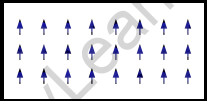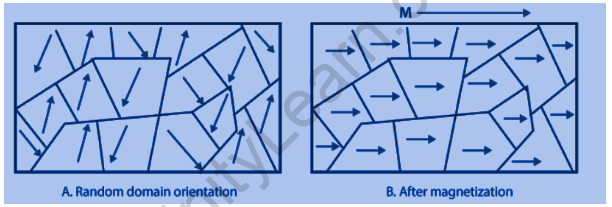Table of Contents
Introduction
The basic mechanism by which certain materials (such as iron) form permanent magnets or are attracted to magnets is known as ferromagnetism. Magnetism is classified into several types in physics. The strongest type, ferromagnetism (along with the similar effect ferrimagnetism), is responsible for the common phenomenon of magnetism in magnets encountered in everyday life. Substances respond weakly to magnetic fields using three other types of magnetism—paramagnetism, diamagnetism, and antiferromagnetism—but the forces are usually so weak that they can only be detected in a laboratory using sensitive instruments. A refrigerator magnet, which is used to hold notes on a refrigerator door, is an everyday example of ferromagnetism. Permanent magnets (materials that can be magnetized by an external magnetic field and remain magnetized after the external field is removed) and the materials that are noticeably attracted to them are either ferromagnetic or ferrimagnetic. Only a few materials are ferromagnetic. Iron, cobalt, nickel, and most of their alloys, as well as some rare earth metal compounds, are the most common. Ferromagnetism is crucial in industry and modern technology, serving as the foundation for many electrical and electromechanical devices such as electromagnets, electric motors, generators, transformers, magnetic storage devices such as tape recorders, and hard discs, and nondestructive testing of ferrous materials.
There are various types of magnetism, the strongest of which is Ferromagnetism. Ferromagnetic materials, in the absence of an external magnetic field, exhibit spontaneous net magnetization at the atomic level. When a ferromagnetic material is exposed to an external magnetic field, it strongly magnetises in the direction of the field. A magnet is strongly attracted to these materials. They will also retain their magnetization for a period of time after the external magnetising field is removed. This is referred to as hysteresis.
Overview
Magnetically “soft” materials, such as annealed iron, can be magnetized but do not tend to stay magnetized, and magnetically “hard” materials, do. Permanent magnets are made of “hard” ferromagnetic materials like alnico and ferrimagnetic materials like ferrite that are subjected to specific processing in a strong magnetic field to align their internal microcrystalline structure during manufacture, making them extremely difficult to demagnetize. To demagnetize a saturated magnet, a specific magnetic field must be applied, and this threshold is determined by the material’s coercivity. The coercivity of “hard” materials is high, whereas the coercivity of “soft” materials is low. A magnet’s overall strength is measured by its magnetic moment or, alternatively, the total magnetic flux it generates. The local strength of magnetism in a substance is measured by magnetization.

A ferromagnetic material has all of its molecular magnetic dipoles pointing in the same direction.
Ferromagnetism is a rare property found in only a few substances. The transition metals iron, nickel, cobalt, and their alloys, as well as rare earth metal alloys, are the most common. It is a property of a material’s crystalline structure and microstructure, as well as its chemical make-up. Their ferromagnetism is caused by having a large number of unpaired electrons in their d-block in the case of iron and its relatives, or in the f-block in the case of rare-earth metals, as a result of Hund’s rule of maximum multiplicity. Heusler alloys, named after Fritz Heusler, are ferromagnetic metal alloys whose constituents are not themselves ferromagnetic. Non Magnetic alloys, on the other hand, such as stainless steel, are almost entirely composed of ferromagnetic metals.
Ferromagnetic materials
Ferromagnetic materials are a class of substances that exhibit strong magnetism in the direction of the field when a magnetic field is applied to them. Magnetism in these materials is caused primarily by the alignment patterns of their constituent atoms. These atoms have the properties of elementary electromagnets. Rare-earth magnets are a relatively new class of extremely strong ferromagnetic materials. They contain lanthanide elements, which are well-known for carrying large magnetic moments in well-localized f-orbitals.
Para-, dia-and ferromagnetic substances
Diamagnetic materials are weakly magnetic and have a negative susceptibility to magnetic fields. A magnetic field repels diamagnetic materials slightly, and the magnetic properties are lost when the external field is removed. Because all of the electrons in diamagnetic materials are paired, there is no permanent net magnetic moment per atom. The realignment of electron trajectories generated by an external magnetic field causes diamagnetic characteristics. Most elements in the periodic table are diamagnetic, including copper, silver, and gold.
Magnetic fields have a small, positive susceptibility to paramagnetic materials. When a magnetic field is applied to these materials, they are slightly attracted and do not retain their magnetic properties when the external field is removed. Paramagnetic characteristics are induced by the presence of some unpaired electrons, as well as the realignment of electron pathways caused by the external magnetic field. Paramagnetic materials include magnesium, molybdenum, lithium, and tantalum, to name a few.
An external magnetic field makes ferromagnetic materials extremely vulnerable. They are strongly attracted to magnetic fields and can retain their magnetic properties after the external field is removed. Because ferromagnetic materials contain unpaired electrons, their atoms have a net magnetic moment. The presence of magnetic domains gives them strong magnetic properties. A high number of atoms’ moments (1012 to 1015) are aligned parallel in these domains, resulting in a strong magnetic force. The domains of ferromagnetic material are virtually arbitrarily organized when it is unmagnetized, and the net magnetic field for the entire part is zero. When a magnetizing force is applied to the part, the domains align to produce a strong magnetic field. Ferromagnetic materials include iron, nickel, and cobalt. The magnetic particle method is commonly used to inspect components made of these materials.
Causes of Ferromagnetism
In the unmagnetized state of a ferromagnetic material, atomic dipoles in small regions called domains are aligned in the same direction. Even in the absence of an external magnetizing field, the domains have a net magnetic moment.
The magnetic moments of neighbouring domains, on the other hand, are oriented in opposite directions. They cancel out, so the material’s net magnetic moment is zero. When an external magnetic field is applied, these domains all align in the direction of the applied field. The material is strongly magnetized in a direction parallel to the magnetizing field in this manner.

Examples of Ferromagnetic Materials
The majority of ferromagnetic materials are metals. Iron, cobalt, nickel, and other ferromagnetic metals are common examples. In addition, metallic alloys and rare earth magnets are ferromagnetic materials. Magnetite is a ferromagnetic material formed by the oxidation of iron to form an oxide. It has a Curie temperature of 580 degrees Celsius. It was previously recognized as a magnetic substance. Magnetite has the highest magnetism of any natural mineral on the planet.
Properties of Ferromagnetic Materials
Ferromagnetic atoms have a permanent dipole moment that is present in domains.
In ferromagnetic substances, atomic dipoles are oriented in the same direction as the external magnetic field.
The magnetic dipole moment is large and directed toward the magnetizing field.
The magnetization intensity (M) is very high and positive, and it varies linearly with the magnetizing field (H). As a result, saturation is determined by the nature of the material.
Magnetic susceptibility is extremely high and positive. Magnetic susceptibility Xm = M / H, where M denotes magnetization intensity and H denotes the strength of the applied magnetic field. The material’s magnetic flux density will be extremely high and positive. Inside ferromagnetic materials, magnetic field lines become extremely dense.
The material’s magnetic flux density will be extremely high and positive. Inside ferromagnetic materials, magnetic field lines become extremely dense. Magnetic flux density B=e0 (H+M) where e0 denotes the magnetic permittivity of free space, H denotes the strength of the applied magnetic field, and M denotes the magnetization intensity.
The relative permeability is also very high and varies linearly with the magnetizing field, indicating that the field within the material is much stronger than the magnetizing field. The material tends to pull in a large number of lines of force.
The field strongly attracts ferromagnetic substances. As a result, in a non-uniform field, they tend to congregate at the poles where the field is strongest.
Because the field is greatest at the poles, ferromagnetic powder accumulates on the sides and displays depression in the centre when placed in a watch glass with two poles spaced enough apart.
FAQs
What is the relationship between ferromagnetism and the temperature of Curie?
When a metal or substance is exposed to an electromagnetic field, it undergoes ferromagnetism, which transforms it into a highly magnetic substance or a strong permanent magnet. When these substances are removed from the magnetic field, they retain their properties as strong permanent magnets. This process occurs only in solids and is not present in liquids or gases. However, when ferromagnetic substances are exposed to high temperatures, they lose their magnetic properties.
What causes ferromagnetism in ferromagnetic materials?
In an unmagnetized ferromagnetic substance, atomic dipoles in small areas called domains are oriented in the same direction. The domains have a net magnetic moment even in the absence of an external magnetizing field. However, magnetic moments in neighbouring domains are oriented in opposite directions. They cancel each other out, so the material's net magnetic moment is zero.









